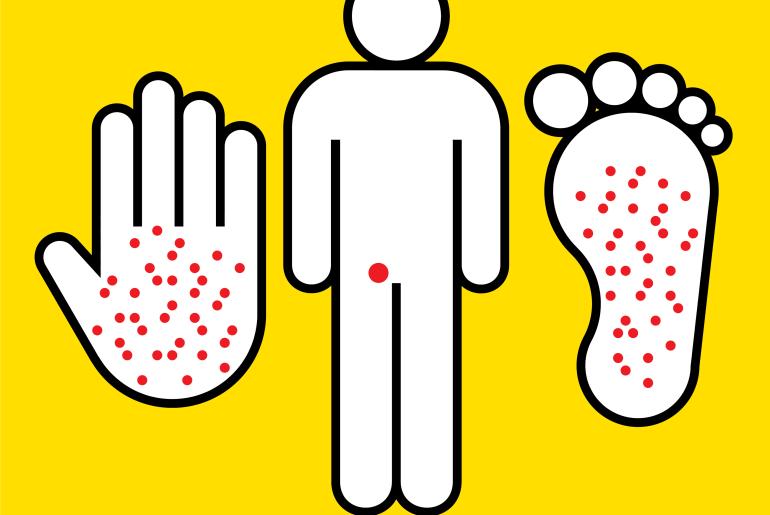For further information, please review: Canadian Paediatric Society: Congenital Syphilis: No longer just of Historical Interest
Reporting Obligations
Individuals with suspect or confirmed cases must be reported to the Thunder Bay District Health Unit by the next working day by fax, phone or mail.
- Fax: (807) 625-4822
- Phone: (807) 625-8318 or toll-free at 1-888-294-6630, ext. 8318
- Mail: 999 Balmoral Street, Thunder Bay, ON P7B 6E7
Please complete the Syphilis Follow Up Form for confirmed cases and submit to TBDHU via fax.
Epidemiology
Aetiologic Agent:
The spirochete Treponema pallidum, subspecies pallidum is the infective agent.
Clinical Presentation:
An acute and chronic treponemal disease characterized clinically by a primary lesion, a secondary eruption involving skin and mucous membranes, long periods of latency, and late lesions of skin, bone, viscera, the central nervous system (CNS) and cardiovascular system.
The primary lesion (chancre) usually appears 3 weeks after exposure. Four stages in syphilis infection include: primary, secondary, latent and tertiary.
- Primary syphilis is characterized by one or more painless superficial chancres at the site of exposure and regional lymphadenopathy.
- Secondary syphilis develops 2 -12 weeks following resolution of primary lesion and is characterized by macular, maculopapular or papular lesions or a rash, typically involving palms, soles and flexor areas of extremities and regional lymphadenopathy.
- Latent syphilis is serological evidence of infection in the absence of symptoms and is further defined as: Early latent syphilis, acquired within the preceding year, and late latent syphilis, all other cases of latent syphilis. If left untreated, late latent syphilis can progress to tertiary (rare) or neurosyphilis. Tertiary syphilis may manifest as mucotanous/osseous lesions where cardiovascular involvement and neurosyphilis is present and typically is not infectious.
Primary, secondary and early latent syphilis are considered infectious.
Congenital syphilis can result in stillbirth, hydrops fetalis or preterm birth, as well as other systemic complications within the first 4-8 weeks of life.
Modes of transmission:
Spread by sexual contact, including vaginal, oral and anal sex, and also from an infected pregnant parent to their infant before or at the time of birth.
Transmission of syphilis from pregnant parent to fetus is most probable during early syphilis, but can occur throughout the latent period. Infected infants may have moist mucocutaneous lesions that are more widespread than in adult syphilis and are a potential source of infection.
Incubation Period:
From 10 days to 3 months; usually 3 weeks
Period of Communicability:
Communicability exists when moist mucocutaneous lesions of primary and secondary syphilis are present. Primary, secondary, and early latent syphilis are considered infectious.
Risk Factors/Susceptibility
- Those who have had sexual contact with a known case of syphilis and in the following individuals: MSM, sex workers, those with street involvement/homeless, injection drug users, those with multiple sexual partners, those with a history of syphilis, HIV and other STIs, those originating from or having sex with an individual from a country with a high prevalence of syphilis.
- Individuals of Indigenous ethnicity are disproportionately affected by syphilis in some geographic areas of Canada, particularly in some areas experiencing outbreaks of infectious syphilis.
- In Ontario, syphilis has been more prevalent among men having sex with men (MSM), with transmission occurring through oral and anal contact. Rates are climbing among men in the 40-44 age group.
Diagnosis & Laboratory Testing
Diagnosis of syphilis requires combination of history including epidemiologic risk factors or exposure, physical examination and laboratory tests as there is no single optimum diagnostic criterion.
Testing Information & Requisition
Clinical algorithm for syphilis staging and treatment
Canadian Syphilis Guide: Screening and diagnostic testing
Treatment & Case Management
Treatment is under the direction of the attending health care provider. Refer to the Syphilis Chapter in the Canadian Guidelines on Sexually Transmitted Infections.
Syphilis Guide - Treatment and follow-up
Syphilis Guide - Reporting and Partner Notification
Patient Information
Health Care Provider Resources
References
1. Ministry of Health and Long Term Care, Infectious Diseases Protocol - Appendix 1 (2025) Syphilis.
